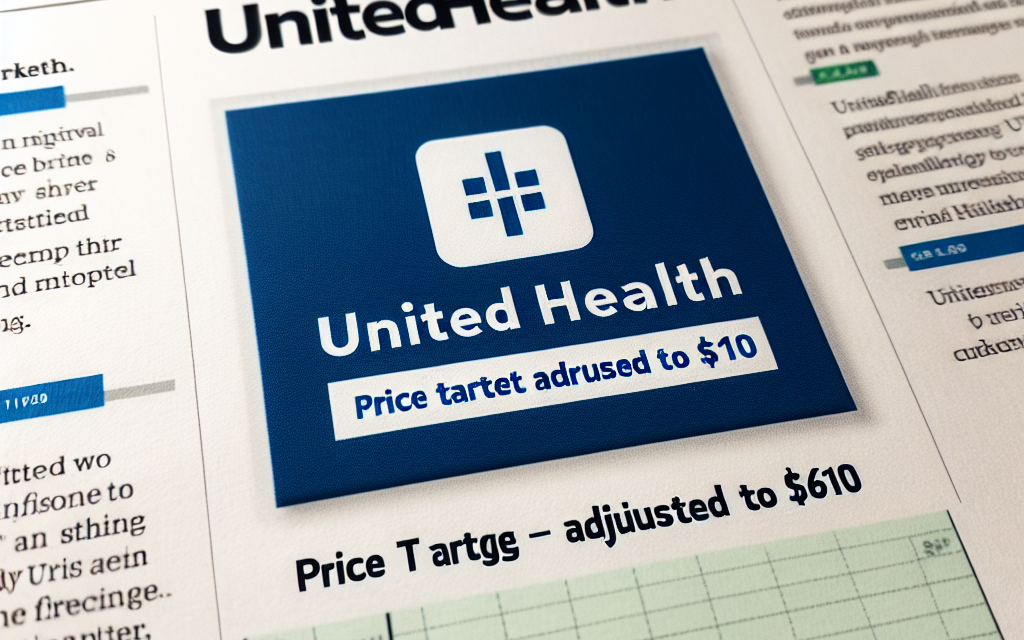“Truist Elevates UnitedHealth Price Target to $610: A Stronger Future Ahead.”
Introduction
Truist has adjusted its price target for UnitedHealth Group to $610, reflecting a positive outlook on the company’s growth potential and market position. This revision comes amid strong performance indicators and strategic initiatives that suggest continued profitability and expansion in the healthcare sector. Analysts at Truist believe that UnitedHealth’s diversified business model and robust service offerings will drive sustained revenue growth, justifying the increased price target.
UnitedHealth Price Target Adjustment Overview
In a recent development that has captured the attention of investors and analysts alike, Truist has adjusted its price target for UnitedHealth Group Incorporated to $610. This revision reflects a comprehensive analysis of the company’s performance, market conditions, and future growth prospects. UnitedHealth, a leading player in the healthcare sector, has consistently demonstrated resilience and adaptability, factors that have contributed to its robust market position. The adjustment by Truist is indicative of a broader confidence in the company’s strategic initiatives and operational efficiency.
Truist’s decision to raise the price target is grounded in a thorough evaluation of UnitedHealth’s financial health and its ability to navigate the complexities of the healthcare landscape. The company has shown remarkable growth in its revenue streams, particularly through its diversified business model that encompasses both health insurance and healthcare services. This dual approach not only mitigates risks associated with market fluctuations but also positions UnitedHealth to capitalize on emerging opportunities within the healthcare sector. As the demand for healthcare services continues to rise, driven by an aging population and increasing prevalence of chronic diseases, UnitedHealth is well-positioned to leverage its extensive network and resources.
Moreover, the adjustment in the price target comes at a time when the healthcare industry is undergoing significant transformation. Regulatory changes, technological advancements, and shifting consumer preferences are reshaping the way healthcare is delivered and consumed. UnitedHealth has been proactive in adapting to these changes, investing in innovative solutions that enhance patient care and streamline operations. For instance, the company’s focus on telehealth services and digital health platforms has not only improved access to care but has also resulted in cost efficiencies. Such initiatives are likely to drive further growth and profitability, reinforcing Truist’s optimistic outlook.
In addition to its strategic initiatives, UnitedHealth’s strong financial performance has been a key factor in Truist’s price target adjustment. The company has consistently reported solid earnings, driven by its ability to manage costs effectively while expanding its member base. This financial stability is crucial, especially in an environment where economic uncertainties can impact consumer spending and healthcare utilization. By maintaining a strong balance sheet and generating healthy cash flows, UnitedHealth has positioned itself to weather potential downturns and continue investing in growth opportunities.
Furthermore, the competitive landscape within the healthcare sector cannot be overlooked. UnitedHealth faces competition from various players, including traditional insurers and emerging health technology companies. However, the company’s established brand reputation, extensive provider network, and commitment to quality care give it a distinct advantage. As Truist highlights in its analysis, UnitedHealth’s ability to innovate and adapt to market demands will be pivotal in maintaining its leadership position.
In conclusion, Truist’s adjustment of UnitedHealth’s price target to $610 underscores a positive outlook for the company amidst a dynamic healthcare environment. The combination of strategic initiatives, strong financial performance, and a commitment to innovation positions UnitedHealth favorably for future growth. As the healthcare landscape continues to evolve, stakeholders will be closely monitoring the company’s progress and its ability to capitalize on emerging trends. With a solid foundation and a forward-looking approach, UnitedHealth is poised to navigate the challenges and opportunities that lie ahead, making it a compelling consideration for investors.
Impact of Truist’s Price Target on UnitedHealth Stock
Truist Financial has recently adjusted its price target for UnitedHealth Group Incorporated to $610, a move that has garnered significant attention in the financial markets. This adjustment reflects a broader analysis of UnitedHealth’s performance, market position, and future growth potential. As one of the largest health insurance companies in the United States, UnitedHealth plays a crucial role in the healthcare sector, and any changes in its stock price target can have substantial implications for investors and the industry as a whole.
The revised price target by Truist is indicative of a positive outlook on UnitedHealth’s operational efficiency and its ability to navigate the complexities of the healthcare landscape. Analysts at Truist have likely considered various factors, including UnitedHealth’s robust revenue growth, strategic acquisitions, and its diversified business model, which encompasses both health insurance and healthcare services. By focusing on these strengths, Truist’s analysts have positioned UnitedHealth as a resilient player capable of adapting to market fluctuations and regulatory changes.
Moreover, the adjustment to the price target can influence investor sentiment significantly. When a reputable financial institution like Truist raises its price target, it often instills confidence among investors, leading to increased buying activity. This heightened interest can drive up the stock price, creating a positive feedback loop where rising prices attract more investors, further bolstering the stock’s performance. Consequently, this can enhance UnitedHealth’s market capitalization, providing the company with greater leverage for future investments and growth initiatives.
In addition to the immediate effects on stock price, Truist’s revised target may also impact the broader healthcare sector. As UnitedHealth is a bellwether for health insurance stocks, its performance can set the tone for other companies in the industry. If UnitedHealth’s stock rises in response to the new price target, it may encourage other health insurers to reassess their own strategies and performance metrics. This ripple effect can lead to a more competitive environment, prompting companies to innovate and improve their service offerings to attract and retain customers.
Furthermore, the adjustment in price target aligns with the ongoing trends in the healthcare industry, particularly the increasing emphasis on value-based care and integrated health services. UnitedHealth has been at the forefront of these trends, leveraging technology and data analytics to enhance patient outcomes while controlling costs. As investors become more aware of these strategic initiatives, they may view UnitedHealth as a leader in the transition towards a more efficient healthcare system, further justifying the higher price target.
However, it is essential to consider potential risks that could affect UnitedHealth’s stock performance despite the optimistic outlook. Regulatory changes, shifts in consumer behavior, and economic uncertainties can all pose challenges to the company’s growth trajectory. Investors must remain vigilant and assess these factors alongside the positive indicators highlighted by Truist’s analysis.
In conclusion, Truist’s adjustment of UnitedHealth’s price target to $610 reflects a comprehensive evaluation of the company’s strengths and market dynamics. This change not only influences investor sentiment and stock performance but also has broader implications for the healthcare sector. As UnitedHealth continues to navigate the complexities of the industry, its ability to adapt and innovate will be critical in maintaining investor confidence and achieving sustained growth.
Analysis of UnitedHealth’s Financial Performance
UnitedHealth Group, a leading player in the healthcare sector, has recently garnered attention following Truist’s adjustment of its price target to $610. This revision reflects a comprehensive analysis of the company’s financial performance, which has demonstrated resilience and adaptability in a rapidly evolving market. To understand the implications of this price target adjustment, it is essential to delve into the various facets of UnitedHealth’s financial health, operational efficiency, and strategic initiatives.
Firstly, UnitedHealth’s revenue growth has been a significant driver of its financial performance. The company has consistently reported strong earnings, bolstered by its diversified business model that encompasses both health benefits and health services. This dual approach not only mitigates risks associated with market fluctuations but also positions UnitedHealth to capitalize on emerging opportunities within the healthcare landscape. For instance, the integration of technology in healthcare delivery has allowed the company to enhance patient engagement and streamline operations, ultimately leading to improved financial outcomes.
Moreover, UnitedHealth’s ability to manage costs effectively has played a crucial role in its financial success. The company has implemented various strategies aimed at optimizing operational efficiencies, which have resulted in a favorable cost structure. By leveraging data analytics and innovative care management solutions, UnitedHealth has been able to reduce unnecessary expenditures while maintaining high-quality care for its members. This focus on cost management is particularly important in an environment where healthcare expenses continue to rise, and it underscores the company’s commitment to delivering value to both its customers and shareholders.
In addition to revenue growth and cost management, UnitedHealth’s strategic acquisitions have further strengthened its market position. The company’s recent acquisitions have not only expanded its service offerings but have also enhanced its competitive edge. By integrating new technologies and capabilities, UnitedHealth has been able to improve its service delivery and patient outcomes, which in turn drives member satisfaction and retention. This strategic focus on growth through acquisition is indicative of UnitedHealth’s proactive approach to navigating the complexities of the healthcare industry.
Furthermore, the company’s robust cash flow generation has provided it with the financial flexibility to invest in future growth initiatives. UnitedHealth’s strong balance sheet, characterized by manageable debt levels and substantial liquidity, enables it to pursue strategic investments that can yield long-term benefits. This financial strength is particularly noteworthy in the context of ongoing uncertainties in the global economy, as it positions UnitedHealth to weather potential downturns while continuing to invest in innovation and expansion.
As Truist adjusts its price target for UnitedHealth to $610, it reflects a broader recognition of the company’s solid fundamentals and growth potential. Analysts are increasingly optimistic about UnitedHealth’s ability to navigate the challenges posed by regulatory changes, competitive pressures, and evolving consumer preferences. The company’s commitment to enhancing healthcare access and affordability aligns with broader industry trends, positioning it favorably for sustained growth.
In conclusion, UnitedHealth’s financial performance is characterized by strong revenue growth, effective cost management, strategic acquisitions, and robust cash flow generation. These elements collectively contribute to a positive outlook for the company, as evidenced by Truist’s price target adjustment. As UnitedHealth continues to adapt to the dynamic healthcare landscape, its ability to leverage its strengths will be critical in maintaining its leadership position and delivering value to its stakeholders.
Market Reactions to Truist’s Price Target Change
In a recent development that has captured the attention of investors and analysts alike, Truist Financial has adjusted its price target for UnitedHealth Group to $610. This revision reflects a nuanced understanding of the healthcare giant’s market position and growth potential, particularly in light of evolving industry dynamics and economic conditions. The adjustment has prompted a variety of market reactions, underscoring the significance of such changes in the financial landscape.
Truist’s decision to raise the price target is rooted in a comprehensive analysis of UnitedHealth’s operational performance and strategic initiatives. The firm has highlighted the company’s robust revenue growth, driven by its diversified business model that encompasses both health insurance and healthcare services. This dual approach not only mitigates risks associated with market fluctuations but also positions UnitedHealth to capitalize on emerging opportunities within the healthcare sector. As a result, investors are increasingly optimistic about the company’s ability to sustain its growth trajectory, which is reflected in the uptick in stock prices following the announcement.
Moreover, the healthcare industry is undergoing significant transformations, influenced by technological advancements and regulatory changes. UnitedHealth has been at the forefront of these developments, leveraging technology to enhance patient care and streamline operations. By investing in telehealth services and data analytics, the company is not only improving patient outcomes but also reducing costs, which is a critical factor in maintaining profitability. Consequently, Truist’s revised price target aligns with a broader market sentiment that recognizes the potential for continued innovation and efficiency gains within UnitedHealth’s operations.
In addition to the operational strengths, market reactions have also been shaped by macroeconomic factors. The ongoing discussions surrounding healthcare reform and policy changes have created a complex environment for healthcare providers. However, UnitedHealth’s established market presence and adaptability have positioned it favorably to navigate these challenges. Investors are increasingly viewing the company as a resilient player capable of weathering economic uncertainties, which has contributed to the positive reception of Truist’s price target adjustment.
Furthermore, the broader market context plays a crucial role in shaping investor sentiment. As the stock market experiences fluctuations, driven by various economic indicators and geopolitical events, companies like UnitedHealth often become focal points for investors seeking stability. The adjustment in price target by Truist not only reinforces confidence in UnitedHealth’s fundamentals but also serves as a signal to the market that the company is well-equipped to thrive in a competitive landscape.
As the market digests Truist’s revised price target, analysts and investors will be closely monitoring UnitedHealth’s performance in the coming quarters. The company’s ability to execute its strategic initiatives and respond to market demands will be critical in determining whether the optimistic outlook is realized. In this context, the adjustment serves as a reminder of the dynamic nature of the healthcare sector and the importance of informed decision-making in investment strategies.
In conclusion, Truist’s adjustment of UnitedHealth’s price target to $610 has elicited a positive response from the market, reflecting confidence in the company’s growth potential and operational resilience. As investors navigate the complexities of the healthcare landscape, this development underscores the importance of strategic insights and market analysis in shaping investment decisions. The interplay between UnitedHealth’s performance and broader economic trends will continue to be a focal point for stakeholders as they assess the company’s trajectory in an ever-evolving industry.
Future Projections for UnitedHealth’s Growth
In recent developments, Truist has adjusted its price target for UnitedHealth Group to $610, reflecting a positive outlook on the company’s future growth potential. This adjustment comes amid a broader analysis of the healthcare sector, where UnitedHealth stands out as a leader in both health insurance and healthcare services. The company’s diversified business model, which includes its Optum segment, positions it well to capitalize on the increasing demand for integrated healthcare solutions. As the healthcare landscape continues to evolve, UnitedHealth’s ability to adapt and innovate will be crucial in maintaining its competitive edge.
One of the key factors contributing to UnitedHealth’s optimistic growth projections is its robust financial performance. The company has consistently demonstrated strong revenue growth, driven by an expanding membership base and increased demand for its services. As more individuals seek comprehensive healthcare coverage, UnitedHealth is well-positioned to capture a larger market share. Furthermore, the company’s strategic investments in technology and data analytics enhance its operational efficiency, allowing it to deliver better outcomes for its members while controlling costs.
In addition to its financial strength, UnitedHealth’s commitment to value-based care is another significant driver of its future growth. By focusing on preventive care and chronic disease management, the company aims to improve patient outcomes while reducing overall healthcare expenditures. This approach not only aligns with the shifting priorities of healthcare consumers but also resonates with policymakers who are increasingly advocating for cost-effective healthcare solutions. As the industry moves towards value-based models, UnitedHealth’s early adoption of these practices places it at the forefront of this transformation.
Moreover, the ongoing expansion of telehealth services presents a substantial opportunity for UnitedHealth. The COVID-19 pandemic accelerated the adoption of telemedicine, and this trend is expected to persist as patients and providers recognize the convenience and accessibility it offers. UnitedHealth’s investments in digital health platforms position it to leverage this growing demand, further enhancing its service offerings and improving patient engagement. By integrating telehealth into its existing services, UnitedHealth can provide a seamless experience for its members, ultimately driving higher satisfaction and retention rates.
As regulatory changes continue to shape the healthcare environment, UnitedHealth’s proactive approach to compliance and risk management will be essential. The company has demonstrated an ability to navigate complex regulatory landscapes, ensuring that it remains in good standing with government agencies while adapting to new policies. This agility not only mitigates potential risks but also allows UnitedHealth to seize opportunities that arise from regulatory shifts, such as changes in reimbursement models or new healthcare initiatives.
Looking ahead, the potential for mergers and acquisitions within the healthcare sector could also play a pivotal role in UnitedHealth’s growth trajectory. The company has a history of successfully integrating acquired entities, which has enabled it to expand its service offerings and enhance its market presence. As the healthcare industry continues to consolidate, UnitedHealth’s strategic acquisitions could further bolster its competitive position and drive long-term growth.
In conclusion, Truist’s adjustment of UnitedHealth’s price target to $610 underscores the company’s promising future. With its strong financial performance, commitment to value-based care, expansion of telehealth services, adeptness in navigating regulatory changes, and potential for strategic acquisitions, UnitedHealth is well-equipped to thrive in an evolving healthcare landscape. As these factors converge, investors and stakeholders alike can anticipate a period of sustained growth and innovation for this industry leader.
Comparison of UnitedHealth’s Price Target with Competitors
In the ever-evolving landscape of the healthcare sector, UnitedHealth Group has consistently emerged as a formidable player, demonstrating resilience and adaptability in a competitive market. Recently, Truist Financial adjusted its price target for UnitedHealth to $610, reflecting a positive outlook on the company’s growth trajectory and operational efficiency. This adjustment invites a closer examination of how UnitedHealth’s price target compares with those of its competitors, providing valuable insights into the broader dynamics of the healthcare industry.
To begin with, it is essential to consider the context in which UnitedHealth operates. As one of the largest health insurers in the United States, UnitedHealth has a diverse portfolio that includes health benefits and services through its UnitedHealthcare and Optum divisions. This diversification not only mitigates risk but also positions the company to capitalize on various revenue streams. In contrast, competitors such as Anthem and Cigna have also made significant strides in the market, yet their price targets reflect different strategic focuses and market perceptions. For instance, while Anthem’s price target hovers around $500, Cigna’s is slightly lower, indicating a more cautious outlook compared to UnitedHealth’s robust valuation.
Moreover, the competitive landscape is further complicated by the emergence of new players and the ongoing consolidation within the industry. Companies like Humana and Centene are also vying for market share, and their respective price targets are indicative of their growth strategies and operational efficiencies. Humana, with a price target of approximately $550, has focused heavily on Medicare Advantage plans, which have proven to be a lucrative segment. In contrast, Centene’s price target reflects its emphasis on Medicaid and government-sponsored programs, which, while stable, may not offer the same growth potential as UnitedHealth’s diversified approach.
Transitioning to the financial metrics that underpin these price targets, it is crucial to analyze the earnings growth projections and market capitalization of these companies. UnitedHealth’s strong earnings growth, driven by its innovative healthcare solutions and strategic acquisitions, has garnered investor confidence, thereby justifying Truist’s optimistic price target. In comparison, Anthem and Cigna have experienced fluctuations in their earnings growth, which may explain their more conservative price targets. Investors often look for consistency in earnings performance, and UnitedHealth’s track record in this regard sets it apart from its competitors.
Furthermore, the regulatory environment plays a significant role in shaping the future of these companies. With ongoing discussions around healthcare reform and potential changes in reimbursement models, the ability of these firms to navigate regulatory challenges will be critical. UnitedHealth’s proactive approach to compliance and its investment in technology to enhance operational efficiency may provide it with a competitive edge over its peers. This adaptability is reflected in its price target, which suggests that analysts believe UnitedHealth is well-positioned to thrive amid potential disruptions.
In conclusion, the adjustment of UnitedHealth’s price target to $610 by Truist Financial underscores the company’s strong market position and growth potential. When compared to its competitors, UnitedHealth’s diversified business model, consistent earnings growth, and strategic adaptability highlight its advantages in the healthcare sector. As the industry continues to evolve, the comparative analysis of price targets among these key players will remain a focal point for investors seeking to understand the dynamics of the healthcare market. Ultimately, UnitedHealth’s ability to maintain its trajectory will be closely watched, as it sets the standard for performance in an increasingly competitive landscape.
Investor Sentiment Following Price Target Adjustment
In recent developments within the healthcare investment landscape, Truist has adjusted its price target for UnitedHealth Group to $610, a move that has garnered significant attention from investors and analysts alike. This adjustment reflects a broader sentiment in the market regarding the potential growth and stability of UnitedHealth, a leading player in the health insurance sector. As investors digest this news, it is essential to consider the implications of such a price target adjustment and how it influences overall investor sentiment.
The decision by Truist to raise its price target is rooted in a comprehensive analysis of UnitedHealth’s financial performance and strategic positioning. The company has consistently demonstrated robust revenue growth, driven by its diversified business model that includes both insurance and healthcare services. This diversification not only mitigates risks associated with fluctuations in any single segment but also positions UnitedHealth to capitalize on emerging trends in the healthcare industry. Consequently, investors are increasingly optimistic about the company’s ability to sustain its growth trajectory, particularly in light of ongoing shifts towards value-based care and integrated health solutions.
Moreover, the adjustment to the price target is indicative of a broader trend among analysts who are recognizing the resilience of healthcare stocks in the face of economic uncertainties. As inflationary pressures and geopolitical tensions continue to create volatility in various sectors, healthcare remains a relatively stable investment. Investors are drawn to companies like UnitedHealth that offer essential services and have demonstrated an ability to adapt to changing market conditions. This stability is further reinforced by UnitedHealth’s strong balance sheet and commitment to innovation, which are critical factors that contribute to investor confidence.
In addition to the financial metrics, the sentiment surrounding UnitedHealth is also influenced by its strategic initiatives and leadership in the industry. The company’s investments in technology and data analytics have positioned it as a frontrunner in improving patient outcomes and operational efficiency. As healthcare increasingly shifts towards digital solutions, UnitedHealth’s proactive approach to integrating technology into its services is likely to enhance its competitive advantage. This forward-thinking strategy resonates well with investors who are keen on companies that not only respond to current market demands but also anticipate future trends.
Furthermore, the adjustment in price target by Truist may also reflect a broader consensus among analysts regarding the potential for continued growth in the healthcare sector. As the population ages and healthcare needs evolve, companies like UnitedHealth are well-positioned to benefit from increased demand for health services. This demographic shift, coupled with ongoing legislative changes aimed at expanding access to care, creates a favorable environment for growth. Investors are likely to view the adjusted price target as a signal of confidence in UnitedHealth’s ability to navigate these changes effectively.
In conclusion, the adjustment of UnitedHealth’s price target to $610 by Truist has significant implications for investor sentiment. It underscores the company’s strong market position, resilience in uncertain economic conditions, and commitment to innovation. As investors weigh these factors, the overall outlook for UnitedHealth appears increasingly positive, suggesting that the company will continue to attract interest from both institutional and retail investors. This sentiment is likely to be further bolstered by ongoing developments in the healthcare sector, reinforcing the notion that UnitedHealth remains a compelling investment opportunity in the current market landscape.
Q&A
1. **What is the new price target for UnitedHealth set by Truist?**
– $610.
2. **Who adjusted the price target for UnitedHealth?**
– Truist.
3. **What is the significance of a price target adjustment?**
– It reflects analysts’ updated expectations for a company’s stock performance.
4. **What factors might lead to a price target adjustment?**
– Changes in company performance, market conditions, or economic outlook.
5. **Is a price target of $610 considered bullish or bearish?**
– Bullish, as it indicates an expectation of stock price increase.
6. **What is UnitedHealth primarily known for?**
– It is a diversified health care company providing health insurance and health services.
7. **How might investors react to the new price target?**
– Investors may view it as a positive signal and consider buying or holding the stock.
Conclusion
Truist has adjusted its price target for UnitedHealth to $610, reflecting a positive outlook on the company’s growth potential and market position. This revision indicates confidence in UnitedHealth’s ability to navigate challenges and capitalize on opportunities within the healthcare sector.





